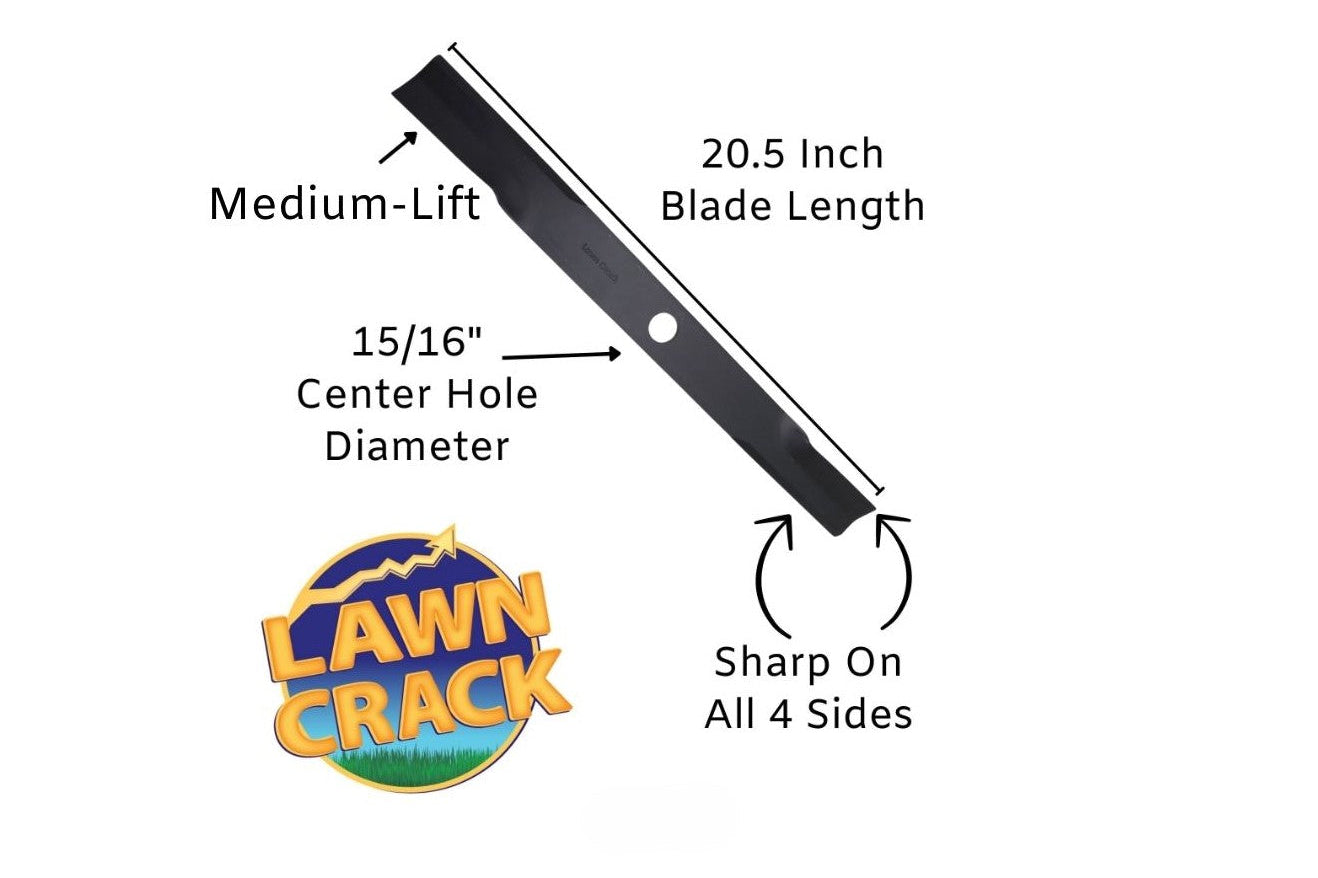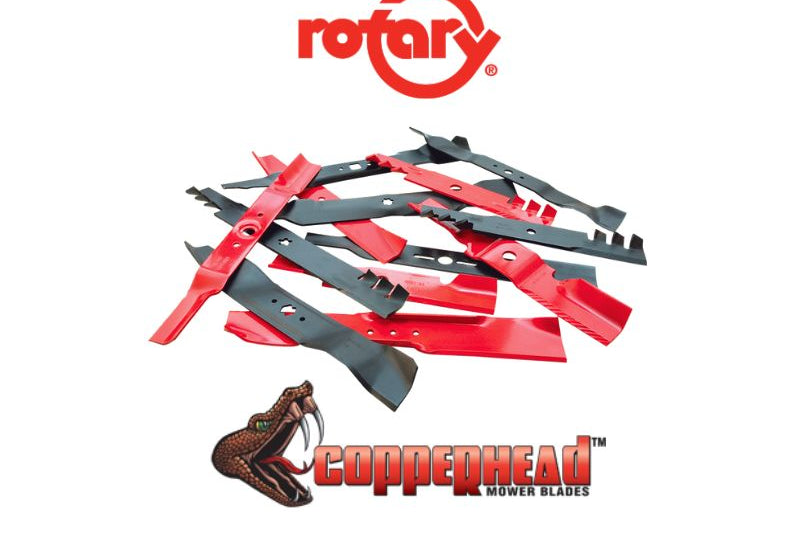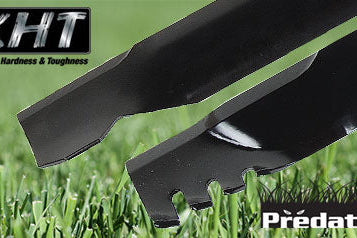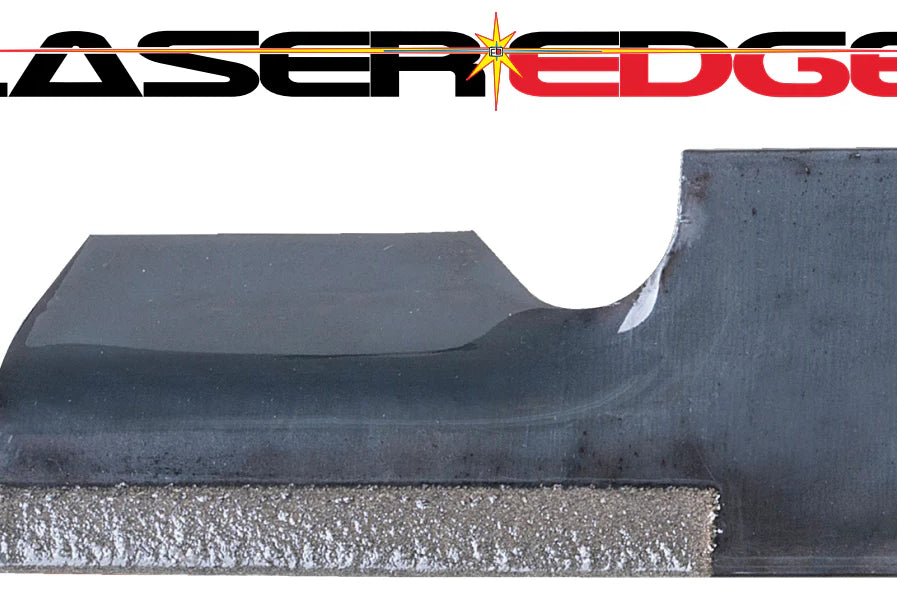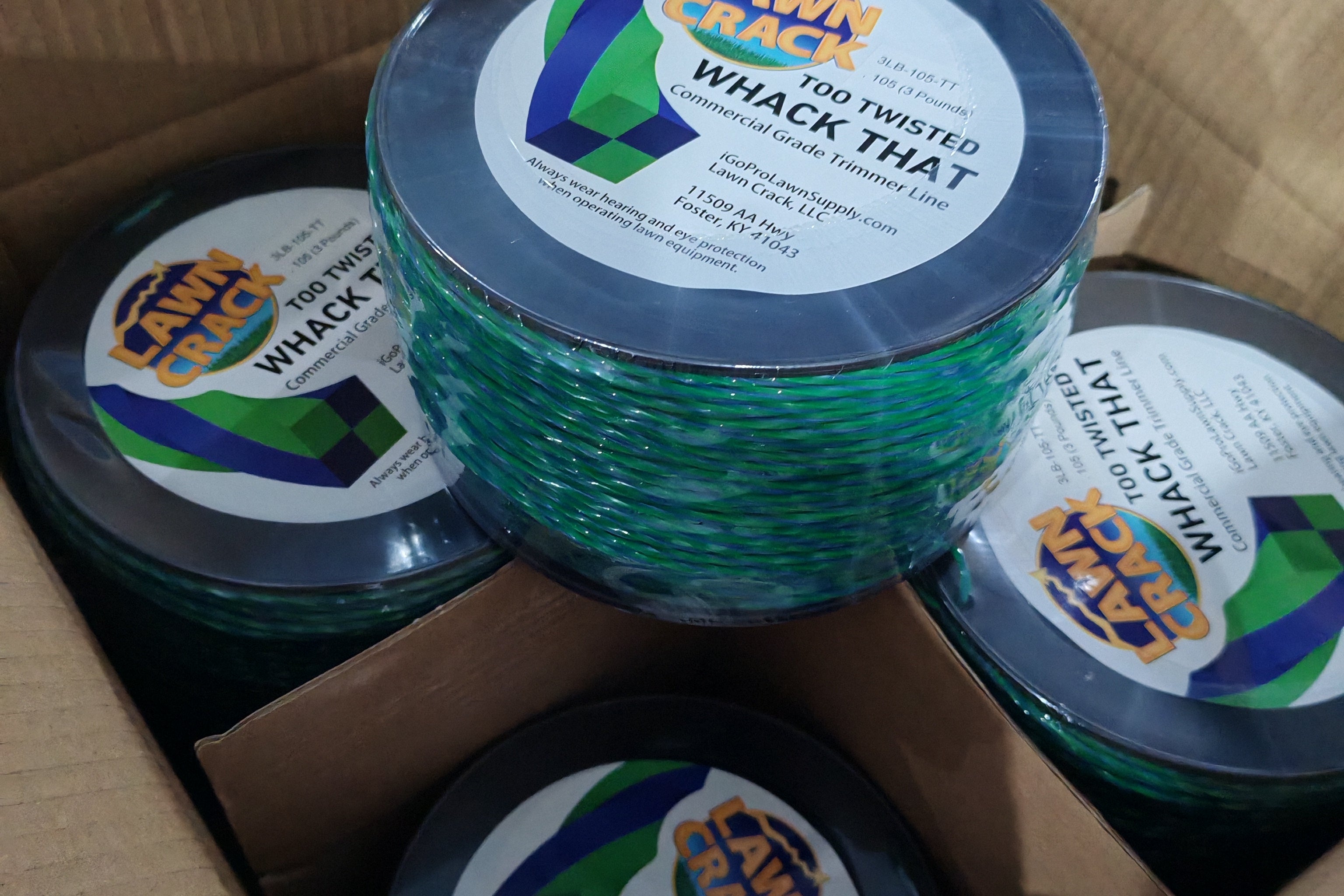Purchasing replacement blades for your lawn mower is a relatively easy task if you know your lawn mower blade's part number. If you have your lawn mower's model and serial number, referencing a parts diagram is how to can find your mower's blade part number.
But, what if you don't have any of these part numbers to reference? How do you determine which blades will fit your mower?
By the time you are finished reading our Ultimate Guide to Lawn Mower Blades article, you should have all the info you need to purchase a blade that will work perfectly with your lawn mower.
We carry Rotary Copperhead blades, Lawn Crack's Hardened Steel blades, XHT/Predator Marbain Steel blades, LaserEdge EverSharp Self-Sharpening blades, and Silver Streak blades by Stens.
Updated Mower Blade Information For 2025 & Beyond
It's early February 2025, and I just got done updating this blog post.
You can now search for lawn mower blades on our website using filters! It's never been easier to find the perfect lawn mower blade for your mower, and the type of cutting you perform.
You can search for blades using specs such as length and center hole diameter. You can also search for blades using the brand of your mower and the deck width. You have all of the tools you need to dial into the perfect lawn mower blade when shopping at iGoProLawnSupply.com.
We also have bulk discounts on certain quantities of each type of blade we carry. Save up to 20% off our already low pricing on high-quality professional lawn mower blades.
Find The Perfect Lawn Mower Blade Here
How to measure lawn mower blades
We'll get into the various types of lawn mower blades a little later in the article (skip to view types of lawn mower blades). First, we will walk you through measuring the blade on your lawn mower to determine which size blade you need.

Measure mower blades diagonally
The most common mistake we see when people are attempting to measure their lawn mower blade is measuring straight across the blade. This is going to give you an inaccurate measurement!
To properly measure a lawn mower blade, measure the blade diagonally from cutting tip to cutting tip. If you are measuring a used blade, keep in mind the actual measurement of a new blade may be slightly longer since the blade on your mower has probably been sharpened several times and material has been removed.
Center hole diameter
The next measurement you will need is the diameter of the center hole of your lawn mower blade.

If your mower blade has 3 holes, make sure you are measuring the center hole!
To measure the diameter, measure straight across.
If your mower blade does not have a circle for the center hole, you will need to determine what the shape is referred to as, such as a 5-point star or 5-point star. More on mower blades without circle-shaped holes in just a second...
If your mower blade has "outside holes"
If you notice 2 holes on either side of the center hole in your lawn mower blade, you will also need to take some measurements here.
Many push lawn mowers and some other types of mowers utilize these outer holes to ensure the blades do not hit each other while in use. Many commercial lawn mowers use 2 or 3 blades, not just 1 blade.
A perfect example of this is the Exmark Commercial 30. This is an oversized 30" wide commercial push mower that utilizes the center holes to ensure each blade is mounted in the correct position.

Once again, you will want to measure the diameter of these holes.
You will also need to measure the distance between the center of these 2 outside holes. This measurement is referred to as center to center.
Lawn mower blade center hole types
Most lawn mower blades have circles as the center hole shape. If your blade does not, here is a quick reference of other possible mower blade center hole types.

Less common but not pictured center hole types include a square and a 7-point star center hole. MTD/Cub Cadet has come out with 'S-Shape' center hole blades.
Measuring your mower blades width
The width of a lawn mower blade is usually not relevant to the fitment of the blade but we wanted to make sure you know how to measure if this is applicable to your mower.

To accurately measure the width, make sure you are measuring straight across and measuring at the widest section of your blade.
Right-hand cut vs left-hand cut blades
Believe it or not, the cutting edge is not on the same side for all lawn mower blades.
Right-hand cut lawn mower blades are overwhelmingly the most common type.

Left-hand cut blades can be found on some mowers manufactured by Hustler, Toro, Kubota, Woods, Walker, and others.
Lawn Mower Blade Thickness
It is recommended to stick with the specs of the blade that came stock on your lawn mower. If, for whatever reason, you cannot determine the OEM blade part number, don't stress about the thickness of the blade. It is not a huge deal, although using a blade that is too thick could lower the RPMs to a point where cut quality is lost or put additional strain on your mower because thicker blades will weight more.
As you might expect, blade thickness is measured by measuring the top of the blade to the bottom.

If you are bending a lot of blades, you may want to purchase a thicker lawn mower blade or just stop hitting rocks! Believe me, I've had 100+ employees in my lawn care business over the years, and I completely understand if you are not sure if your employees are looking at what they are mowing grass! 🤣
Types of lawn mower blades
Now that you understand how to measure lawn mower blades properly and the various types of center holes you may find, let's take a look at the different types of lawn mower blades and when you may want to consider each type.

We should mention you may see "standard blade" in the description of some lawn mower blades. This is basically the middle ground between high-lift and low-lift lawn mower blades. It is pretty suitable for any type of cutting. Also referred to as 'medium-lift.'

High-lift lawn mower blades
High-lift lawn mower blades create a lot of lift due to the exaggerated fin on the non-cutting edge side of the blade.
When to use high lift lawn mower blades:
- When you are cutting tall grass (Grass over 3" tall)
- When you are cutting flimsy grass such as turf-type tall fescue
When not to use high-lift lawn mower blades:
- In sandy soil conditions

Low-lift lawn mower blades
Low-lift lawn mower blades create little lift due to the exaggerated fin on the non-cutting edge side of the blade.
When to use low lift lawn mower blades:
- When you are cutting short grass (Grass under 3" tall)
- When you are cutting rigid grass such as Bermudagrass
- In sandy soil conditions (see flat blades too)
When not to use low lift lawn mower blades:
- When cutting grass over 3.5"

Gator blades
Gator blades are also referred to as 3-in-1. Gator blades are often used by professional mowing companies in the fall to shred leaves as they mow. Some companies run gator blades all year long.
Gator blades also shred longer grass blades before being discharged from the mower's deck. Gator blades do create some lift.
*Gator-style mulching blades do not perform well in all areas! We recommend testing a set before purchasing a large quantity of these style blades. In our area, Greater Cincinnati, gator-style blades leave the fescue grass looking very uneven because they do not create enough lift.
When to use gator blades:
- In the spring or fall to chop up leaves
- When mowing overgrown grass
When not to use gator blades:
- Possible issues in sandy soil conditions

Mulching blades
Mulching blades mulch the grass clippings into fine pieces to allow them to be returned to the soil as natural nutrients.
It is important to note that you can certainly discharge the clippings from the mower's deck back into the lawn without mulching blades as long as you are cutting your grass on a frequent enough basis.
When to use mulching blades:
- When you are not discharging the clippings or bagging
- When you are following the 1/3 rule (only remove 1/3 or less of the grass blade each time you mow)
When not to use mulching blades:
- When cutting overgrown grass
- When bagging or discharging the grass clippings

Flat lawn mower blades
Flat lawn mower blades create zero lift due to the blade being completely flat.
When to use flat lawn mower blades:
- In extremely sandy soil conditions or when cutting a rigid grass type
When not to use flat lawn mower blades:
- Most of the time! Only use flat lawn mower blades when in extremely sandy soil conditions and cutting a rigid grass type
Self-sharpening lawn mower blades
To ensure this article covers all the bases, we wanted to include a new option when it comes to lawn mower blades.
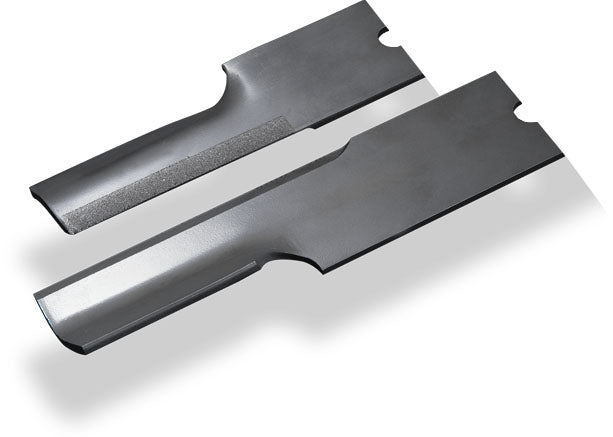
Self-sharpening blades use patented technology to literally sharpen themselves as you mow. The early adopters seem to agree that these blades do, in fact, sharpen themselves.
Of course, these blades come with a hefty price tag as far as lawn mower blades are concerned. It will be for you to determine if they are worth the investment. We sell a lot of these blades to lawn mower companies. The feedback we get from the business owners is that they actually save money by using these blades because they do not have to pay their employees to sharpen blades anymore.
When to sharpen lawn mower blades
Factors such as how much use, what type of grass you are cutting, the length of grass you are cutting, soil conditions, and other factors will determine how often you will need to sharpen your lawn mower blades.
After finishing this article, check out our guide on sharpening lawn mower blades.

The best way to determine when you need to sharpen your lawn mower blades is by simply looking at the cut quality. This refers to the sharpness of the cut you are getting out of your blades. In the picture above, you can clearly see the blades on the lawn mower that cut this grass need to be sharpened as they are tearing the grass instead of cutting it.
How to tell if a mower blade has been sharpened too many times
If you read the manuals, most lawn mower blade manufacturers recommend replacing the blades when there is 1/2" left between the cutting edge and the fin, sail, or lift. The fin, sail, or lift is referring to the part of the blade that is angled up.

If you continue to mow with less than 1/2" of material left, you are putting yourself and others in danger as there is a great possibility this blade could fail and send a piece of the blade flying from your mower. Please take this recommendation seriously!
Even if no one is hurt if this occurs, you very well could be on the hook for property damage costs.
When to replace lawn mower blades
At some point, lawn mower blades can no longer be sharpened and will need to be replaced.
You may need to replace your lawn mower blades because you have sharpened them too many times and have removed too much material from the blade.
Other reasons you may need to replace your lawn mower blades are much more obvious.

For example, if you bend your lawn mower blade, it should be replaced. Please do not attempt to bend it back to being straight once again. The integrity of the blade was lost as soon as it was bent.
Other reasons to replace your lawn mower blades include large chunks missing due to hitting an obstacle or hairline fractures. You should always inspect your lawn mower blades when sharpening, or if you know you just hit an object you shouldn't have!
OEM vs Universal Lawn Mower Blades
Something worth noting about lawn mower blades is that you do not have to stick with the OEM blades that came with your lawn mower!
Some OEM blades simply do not provide a great cut quality. The 2 most important factors when purchasing aftermarket blades are that you purchase blades with the same length and center hole diameter. If your blade has additional outside center holes, you need to account for these specs as well.

Above is an example of a universal replacement blade that has an elongated hole instead of a circle. You will often see this on universal blades that account for outer holes because they want the blade to fit as many makes and models of mowers as possible.
X-Blades (Installing 2 Blades Per Spindle)
I wanted to mention Ballard's X-Blade adaptor that allows you to install 2 blades per spindle. The X-Blade adaptor bracket keeps each blade perpendicular to the other on each spindle.
In theory, this is a great idea, but we want you to consider the additional stress using this will put on your lawn mower's spindles, pulleys, belts, and clutch.
We are currently working with our blade manufacturer to improve this concept in early 2025. We hope to have Lawn Crack's 'Blender' Mower Blade Add-On ready for sale by the summer of 2025.
Where to purchase lawn mower blades?
Great question. You are in the right place!
iGoPro Lawn Supply has over 1,000 lawn mower blades in stock.
We more than likely have the blade you need and have the best price you will find online.
Go ahead and shop lawn mower blades now. We recommend searching for the blade you need by part number, but by now, you are fully prepared to measure your blades and purchase the perfect replacement blade.
Lawn Mower Blade Conclusion
To wrap this up, let's just summarize the most important information we covered.
The 2 most important things to note when purchasing lawn mower blades is the length of the blade and the center hole diameter.
Make sure you purchase a blade with the appropriate outer holes as well if your mower requires them.
Use high-lift blades if you are mowing cool-season grasses.
Consider using low-lift blades if you are mowing warm-season grasses.
Try gator blades if you are mowing long grass or would like to shred leaves as you mow.
Wavy style mulching blades should only be used with a mulching lawn mower or a lawn mower with a mulching kit installed.


